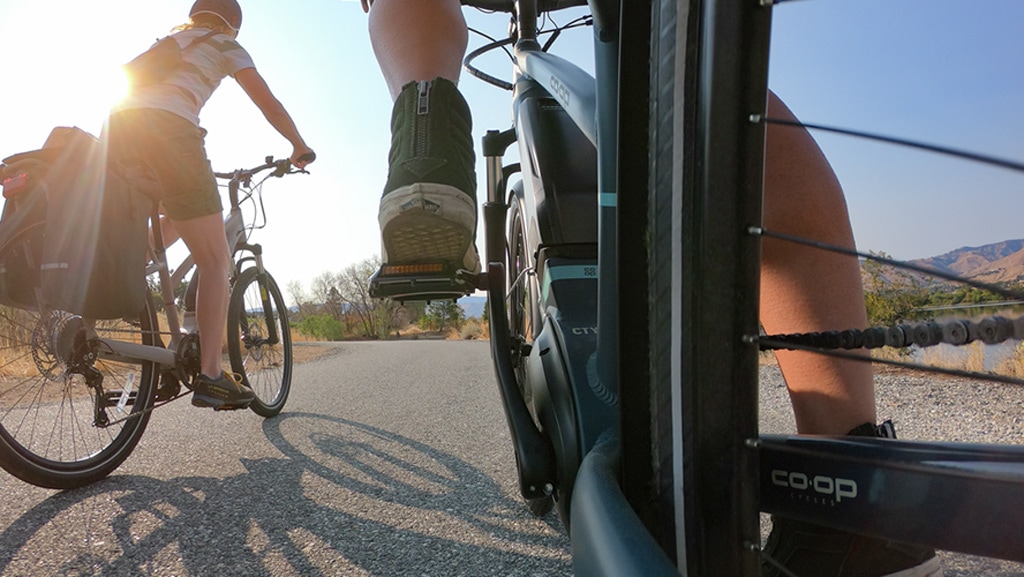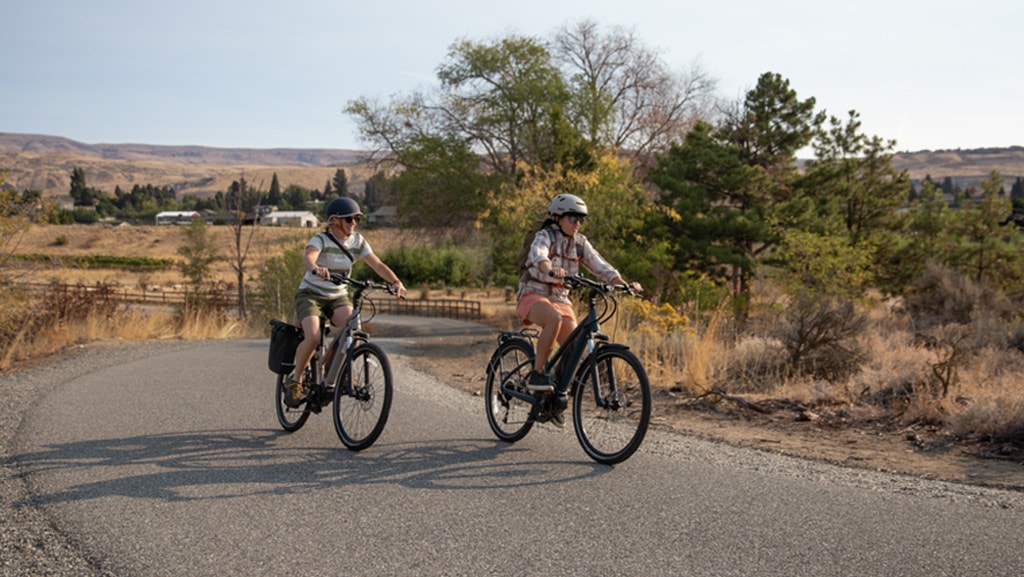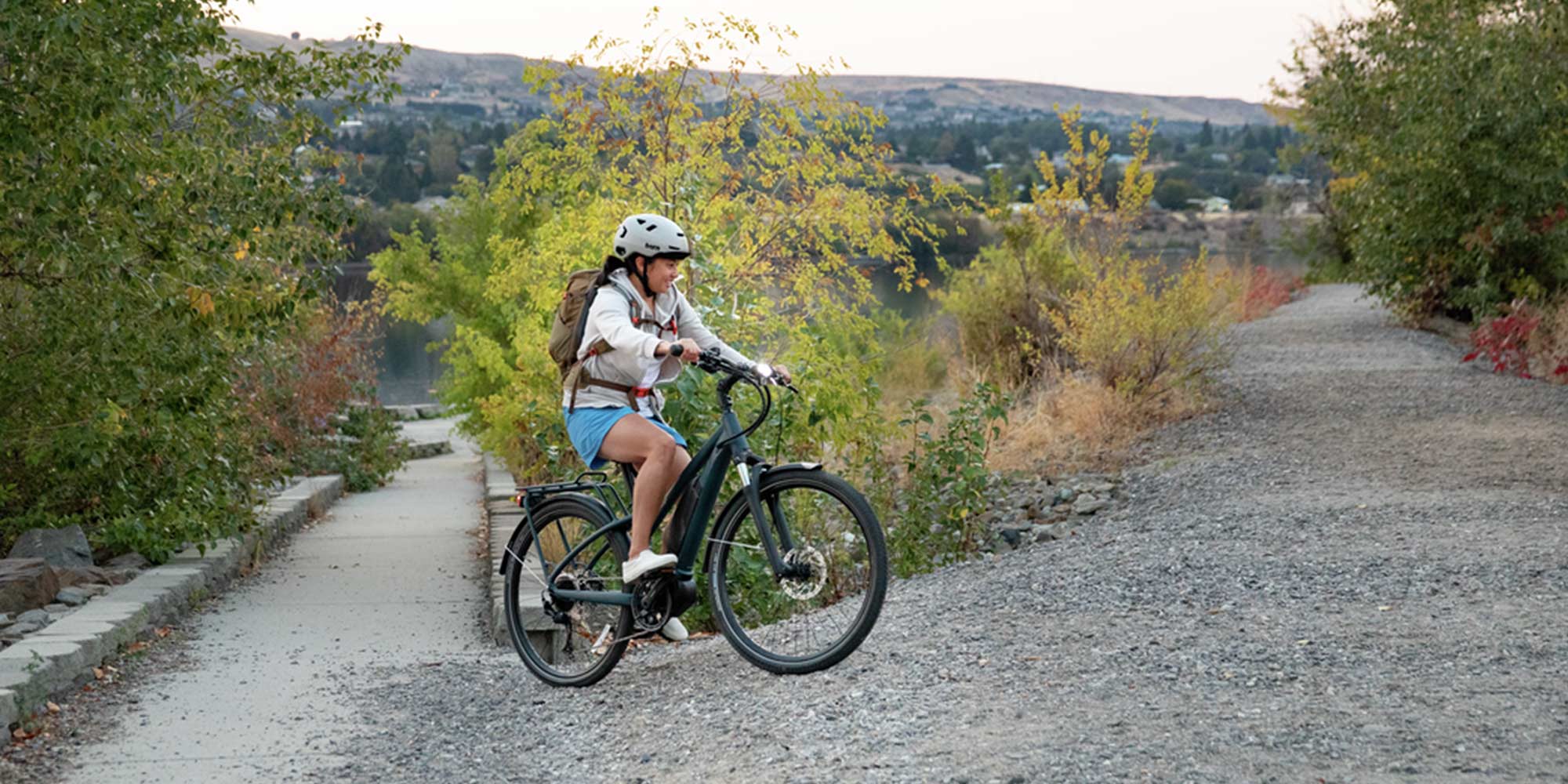You’ve undoubtedly seen them around, standing near the bike rack at the farmer’s market, kicking up dirt on your favorite mountain bike trail or cruising along the neighborhood bike path. E-bikes seem to be everywhere these days. That’s because sales ballooned 145% in 2020 compared with the previous year, according to industry analysts at The NPD Group.
“E-bikes provide riders with the product features to overcome challenges like big hills or [the ability to] go on a longer ride than with a typical bike,” says Dirk Sorenson, sports industry analyst with The NPD Group. “That is a really inviting capability.”
The beauty of an e-bike—with its built-in motor providing assistance as the rider pedals—effectively flattens the terrain, Sorenson adds. So even when the rider is heading up a 5% or 10% grade, they’re cruising, not cursing. But where’s the workout in that?

There’s a common perception that riding an e-bike is like cheating. So how inviting is it for someone looking to work up a sweat and burn calories? Studies to date have been small-scale. But they’ve shown something that may surprise you: Riding an e-bike can provide a pretty good workout.
The reason why is counterintuitive, as one July 2020 study in the International Journal of Environmental Research and Public Health demonstrates. Researchers found that though study volunteers who rode standard bicycles had a higher heart rate and perceived exertion, those on e-bikes had a higher energy expenditure overall. That’s because e-bike users rode more frequently per week. And their total ride time was enough to meet recommended guidelines for 150 minutes of moderate-intensity exercise; when study participants rode standard bikes, however, they didn’t meet those guidelines.
E-bikes “could be a suitable method to enhance health-promoting physical activity in healthy adults,” researchers concluded.
Riding farther, more often
“The biggest benefit for e-bikes is that they allow people who normally wouldn’t ride a bicycle to ride a bicycle—and they ride it more often and they ride it farther,” says Christopher Cherry, professor of civil engineering at the University of Tennessee, Knoxville, and second author on a 2017 study in the Journal of Transport & Health.
The small study tracked 17 participants during three activities: walking, riding a conventional bike and e-biking a hilly 2.75-mile route. The energy expenditure (read: calories burned per minute) was highest for conventional cyclists on the uphill section and for walkers on the downhill section, researchers found. However, the average total energy exerted by participants over the full route was the same whether they walked, biked or rode an e-bike.
Also noteworthy: While e-bikers in this study burned fewer calories overall (they were going faster, which decreased the time they were exerting themselves), they still spent most of their ride in either the moderate or vigorous range of physical activity.

These findings indicate that people have a particular intensity at which they are comfortable working out, says David Bassett, a professor of exercise physiology at the University of Tennessee, Knoxville, and one of the study’s authors. That preferred intensity level is likely to be similar regardless of whether they’re riding an e-bike or a conventional bike; they’re just going faster on the e-bike because they have the electric boost.
“If I wanted to, I could jack it up a hill at 18 miles per hour and I would be working just as hard as I would on a conventional bike going 13 miles per hour,” Bassett says. “Or I can go up at 13 miles per hour [on my e-bike] and I’m doing a moderate intensity.”
That e-bikes give riders more control over their intensity level could have surprising fitness benefits. “It’s not fun when the exertion level just becomes too much for you, when your thighs are burning and your lungs are searing, and you’re like, ‘Oh, I hate this,’” Bassett says. “If you can reduce the effort to a level that is pleasant for you, then the exercise is really, really fun and enjoyable.”
As a result, people may ride longer and go farther. The e-bike effectively “shrinks the distance,” Bassett adds. All of a sudden, a 20-, 30- or even 40-mile ride is completely doable—and it’s fun, he adds. “You’re getting to your destination faster, so the sphere of locations that you can get to in a reasonable amount of time is expanded greatly.”
“E-bikes make cycling a lot more fun, especially for those who maybe don’t have the highest fitness level or confidence.”
James Peterman, lead author of a study on e-bikes
Researchers from the University of Colorado, Boulder also found this to be true. They recruited 20 non-exercisers and instructed them to commute to work by e-bike for a minimum of 40 minutes, three times per week for four weeks. Among their findings: Almost all of the participants rode more often and for longer periods of time than required. They also added errands and family joyrides to their daily routines, notes James Peterman, lead author of the 2016 study in the European Journal of Applied Physiology.
“E-bikes make cycling a lot more fun, especially for those who maybe don’t have the highest fitness level or confidence,” says Peterman, who’s now a research associate at Ball State University. “It’s like riding with a tailwind the whole time.”
Caroline Cooley, 69, knows this feeling. The Knoxville resident has long been an avid road- and mountain biker. About 15 years ago, Cooley noticed her heart and lungs didn’t power her the way they used to. And so, a few years ago, she reluctantly got in the saddle of an e-bike. It was a revelation. “I can go climb some of these things I hadn’t been able to climb in the last few years,” she says. Cooley now does 20-mile trail rides with around 2,000 feet of elevation gain on her e-mountain bike.
Making bicycling more approachable
E-bikes appear to make exercise—and more specifically, cycling—more approachable to those who aren’t avid exercisers, a theory supported by a 2018 study from the Clinical Journal of Sports Medicine. Researchers monitored 32 “untrained, overweight individuals.” Half used e-bikes to commute to work at least three days per week. The others commuted using conventional bikes. The researchers found that the e-bicyclists rode at faster speeds and gained more elevation each day than their counterparts.
That electric tailwind opens the door to many riding scenarios. A new rider has the confidence to bike with more experienced partners because they can keep pace. The cycling fanatic exhausted after a killer hill workout may more likely hop on an e-bike to run errands rather than using a car. And, of course, there’s commuting, which provides a workout while also reducing overall carbon dioxide emissions (another health benefit e-bikes offer).
The beauty of the e-bike is that it gives a rider choices, says researcher Bassett. “If you want to, you can push it on an e-bike just like you can push it on a regular bike. If you want the workout, you can get a workout,” Bassett says. “But you don’t have to. An e-bike gives you flexibility.”
